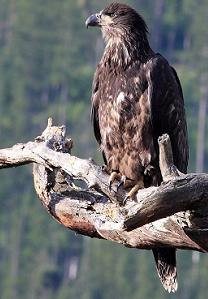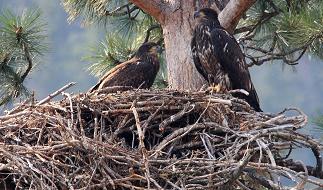Golden Eagle 
Golden Eagles are the national bird of Mexico.
Identification and Pictures
(Aquila chrysaetos)
Golden Eagles are large birds of prey about 30
to 41 inches. Their wing span is 6 to 7 feet. They
are dark brownish, getting a little lighter at the base of the
tail. There is a bit of gold on the back of the neck, and
head. They have a large hooked bill,
good for tearing meat. They have long broad wings, and
tail. The legs are feathered all the way to the
toes. The sexes are similar. Young birds have a white tail, and white at
the base of the wing primaries that can be seen when they
fly. Young Bald Eagles are
often mistaken for Golden Eagles.
Golden Eagles fly with slow wing beats, often soaring
on thermal currents.
Photos by Keith
Lee. The camera I use is the Canon
EOS 40D. Visit All-birds store
Golden Eagle sound
They are not often heard. They have a
high scream, and yelping bark. Sound
Preferred Habitat
Golden Eagles range throughout most of the
Northern Hemisphere. They can be found throughout the
western part of North America, but they are not common in the
east. They like open mountains, canyons, plains, and
foothills.
Breeding and Nesting

Golden Eagles mate at around 4 years and pair
off for life. During their courtship they will dive at
each other while circling high in the air. Both birds will build a nest of sticks, lined with
fine wood materials on a cliff or large tree. They will
normally return to the same nest each year, however they may
have other sites and alternate between them. The
female lays 1 to 4 creamy white eggs with small brown
blotches. Normally the female alone will incubate the
eggs for 41 to 45 days. While she is incubating the male
will bring her food. Both parents will care for the
young birds. The young birds will stay in the nest for
around 10 weeks before fledging. The availability
of food determines whether the eagles will migrate or not.
Food
Being powerful flyers Golden eagles often hunt from the
air. The main diet of Golden eagles is rabbits, hares,
groundhogs, marmots, foxes, and squirrels, but they can, and do
feed on much larger animals such as mountain sheep, and caribou.
They may have a hunting territory of 60 square miles or more.
To learn about other favorite
birds click here.
Golden eagles are protected in the United States.
Possession of a feather or other body part is a felony with a fine of up to $10,000,
and or 10 years in prison. Native Americans are exempt
from this because it is part of their native culture.

|
